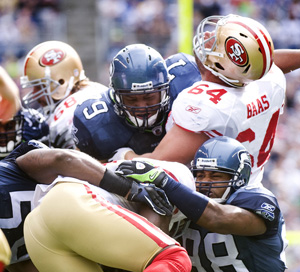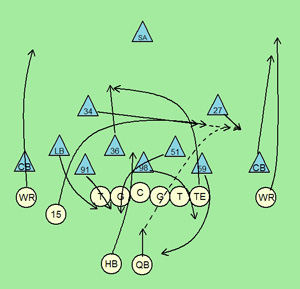
In 2009, the Seattle Seahawks rushed five or more defenders 130 times in 601 possible pass plays, which put the team in the middle of the pack both overall and among teams playing primarily four-man fronts.
But those same Seahawks ranked 29th in Adjusted Sack Rate, and allowed a Defensive DVOA (Football Outsiders’ per-play efficiency metric) of 30.5% on blitzes only the Rams and Titans were worse when rushing more than four. This was less a formation issue and more a matter of personnel, as five years of dubious personnel decisions by team president Tim Ruskell left the team with ill-fitting fronts decimated by injuries.
When Pete Carroll was hired to coach the Seahawks in January, he brought a history of hybrid fronts that went back to his time in New England (head coach, 1997-1999) and San Francisco (defensive coordinator, 1995-1996). Carroll had some interesting ideas about switching between three-and four-lineman fronts, with the point men playing the role of what used to be called the “elephant” and is now called the “leo” position. From the 2010 Football Outsiders Almanac:
“Elephant’ was just an e-word to designate a guy as being different from the regular defensive end,” Carroll told the team’s official site in May. “It’s a position that can take on different sizes and shapes, but it is a spot a little bit of a hybrid position that is kind of a linebacker, kind of a defensive end. We picture it as a speed-oriented guy.” Carroll got great sack seasons out of Chris Doleman in San Francisco and Willie McGinest in New England before he went to USC. For the Trojans, the most obvious beneficiary of the position was Clay Matthews.
The surprise Carroll brought back to the NFL was the first regular 3-4 looks in Seattle in a very long time. Through the Mike Holmgren era, a wave of coordinators ran different versions of 4-3 base defenses with occasionally effective results. Carroll didn’t want what’s been commonplace in the league over the last few years a switch to the 3-4 without the personnel to run it as much as he wanted different defensive concepts to set offenses on their heels.
“I think it’s amazing that (defensive line coach) Dan Quinn can get those guys to come in and play,” Carroll told me this week about the radically overhauled rotation. “They were able to contribute in a big way for such a short time, and everybody went nuts about How can you possibly move forward in that amount of time?’ If the guys understand the game plan, they can do a lot of things.
“That’s not the case for all positions. For example, for (right tackle) Stacy Andrews to come in and get a whole game plan on offense is a huge challenge for an offensive lineman. But on the defensive side, our guys really did come through, and we’re excited about that. They helped us in critical situations and made plays, too. It’s a good system, and really good coaching. Really bright kids who can pick things up quickly it was a combination of all that.”
Against the 49ers in the season opener, Seattle started off with a lot of four-man fronts and the zone coverage common to most Seahawks defenses. This allowed Alex Smith to bail out of the ultra-conservative game plan he’d either been “gifted” with or set on himself early on. Smith went from ill-advised checkdowns on third-and-goal to quick underneath stuff that moved the ball in the second quarter and set the team up to score. San Francisco never did get a touchdown they managed just two field goals in 17 red-zone plays on their first three drives but they outgained Seattle 158-82 in the first half, and Smith was 15 of 20 for 125 yards. Efficient from a completion standpoint, but the YPA of 6.25 and the lack of time in the end zone told another story. The Seahawks made some adjustments at halftime, but things started to get interesting with 1:45 left in the first half.
 San Francisco had third-and-5 from their own 25-yard line in a shotgun, twins left formation. Seattle had a front with just two down linemen Brock (98) shading the center, and Chris Clemons (91) outside the left tackle. The defensive left side was occupied by linebackers Lofa Tatupu (51) and Aaron Curry (59), and safety Lawyer Milloy (36) was cheating up pre-snap as a fifth “lineman.” At the snap, Milloy backed out into coverage, and Curry closed off Smith’s pocket, forcing him to step up. Tatupu and Brock did a little stunt up front, and Smith threw a quick pass to Michael Crabtree that bounced off Crabtree’s hands and into the waiting arms of defensive back Jordan Babineaux (27). Smith hit Crabtree at a weird angle off his right shoulder, but this was also a great example of how the Seahawks defense adjusted to stay aggressive while expecting short stuff underneath.
San Francisco had third-and-5 from their own 25-yard line in a shotgun, twins left formation. Seattle had a front with just two down linemen Brock (98) shading the center, and Chris Clemons (91) outside the left tackle. The defensive left side was occupied by linebackers Lofa Tatupu (51) and Aaron Curry (59), and safety Lawyer Milloy (36) was cheating up pre-snap as a fifth “lineman.” At the snap, Milloy backed out into coverage, and Curry closed off Smith’s pocket, forcing him to step up. Tatupu and Brock did a little stunt up front, and Smith threw a quick pass to Michael Crabtree that bounced off Crabtree’s hands and into the waiting arms of defensive back Jordan Babineaux (27). Smith hit Crabtree at a weird angle off his right shoulder, but this was also a great example of how the Seahawks defense adjusted to stay aggressive while expecting short stuff underneath.
In the second half, Seattle alternated between more true 5-2, with Clemons and Curry as the main ends, and the more straight zone reads that helped cause Smith’s second interception, a miscommunication pick to Marcus Trufant for a Seattle touchdown as Crabtree ran a route Smith wasn’t expecting.
I attended several Seahawks practices during training camp and the preseason, and talked to the players and coaches. It’s bad form to say or write, “Oh I saw this and that, and that’s what they did this” in moving from practice to game action. But suffice to say that the success the Seahawks had with their multiple fronts was a matter of intelligent implementation over time. Smith’s relatively horrible outing helped, but after years of vanilla defenses that did little to enhance whatever talent may have been on the field, the Seahawks are starting to put together some defensive ideas that could transcend short-term roster issues.
